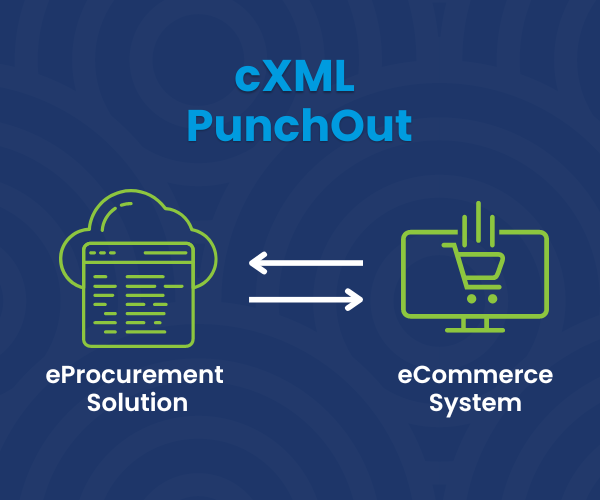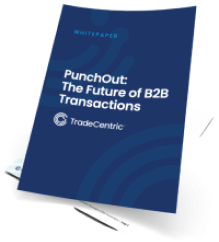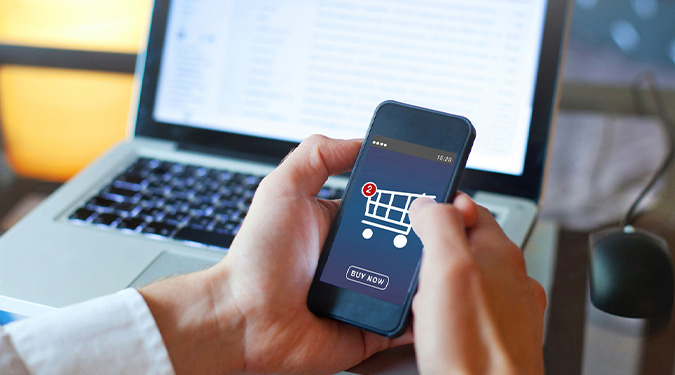Table of Contents
Ever since buyer and supplier systems began communicating with each other in the ’90s, cXML, or commerce extensible markup language, has been one of the main programming languages that make eProcurement possible.
Punchout catalogs use a data format called cXML to integrate a buyer’s procurement system directly with a supplier’s eCommerce site, simplifying the modern B2B buying and selling processes. cXML PunchOut is integral for buyers to shop seamlessly, and not having the integration capabilities will hurt your business sooner than later.
But how does cXML PunchOut work, what happens within the eProcurement system during this process, and what does it look like? The more you know and understand the general XML version and cXML PunchOut process, the more empowered you can be when scaling your own eProcurement system.
How Does cXML PunchOut Work?
The cXML PunchOut process all begins with a PunchOut setup request. A PunchOut setup request is sent from the buyer’s eProcurement system to a PunchOut gateway. This transaction translates the request within the vendor’s system and validates the relevant information such as the user credentials, allowing them to log into the vendor catalog.
From there, customers are able to browse the PunchOut catalogs and build carts that will be sent back through their procurement system and approved to create a requisition order.
Although cXML is used at the beginning of the process during the PunchOut setup request, most of the value between a cXML and PunchOut integration happens during the checkout process. Rather than a traditional checkout process, the shopping cart contents are returned to the customer’s procurement system to go through the approval process.
Once the shopping cart goes through the appropriate approval process, a purchase order is created for the supplier to fill. This is also possible through cXML and PunchOut functionality. In addition, to purchase orders, cXML PunchOut can also help communicate these details between buyers and suppliers:
- Advanced shipping notices
- Invoices
- Other order-related documents and communication

What Happens During the cXML PunchOut Process?
On the back end of the cXML PunchOut process, there are multiple technical steps that happen within every cXML document. Each step is integral to the PunchOut transaction.
PunchOutSetupRequest (POSR) is made – The data within the post often will contain parameters such as unique identifiers that may include the users email address, shipping address, business unit ID, DUNS, and others of which vary from e-procurement systems to system and buyer to buyer that is used by the eCommerce application to properly authenticate the user and reflect the correct offering, pricing, experience, etc.
cXML PunchOut Example
Below is a real-world example of what this information looks like in a doctype cxml system.
- FirstName: John
- Last Name: Doe
- UniqueName: BUZf6d8
- User Email: [email protected]
- User: BUZf6d8
- Business Unit: 13843
- contact: email: [email protected]
- name: BUZf6d8
- unique: BUZf6d8
- buyer cookie: 7555371f46f7a5d057ac3567a2df12c2
- postform: https://acme_buyer.coupahost.com/punchout/checkout?id=1The data will generally include the following information about the punchout user and punchout session:PunchOut Setup Response – The vendor’s eProcurement system returns a URL that redirects the user to begin their shopping experience directly on the vendor’s e-commerce application. The response, if successful, will provide a 200 and redirect the browser to the URL from the response, ie. https://www.ASupplier.com.
Need a PunchOut Catalog Solution?
Check out our recent blog to see more practical cXML Examples.
What are the Benefits of cXML and PunchOut?
We’ve talked about how the integration between commerce XML and a PunchOut catalog is integral to making a seamless connection between a buyer’s procurement system and a supplier’s eCommerce site.
But transferring data between eProcurement applications and choosing cXML PunchOut also has additional benefits for both the buyer and the supplier, including:
- A better way to track and manage spend
- A faster, easier way to do B2B commerce
- PunchOut catalogs have controlled spending limits in place, eliminating rogue orders
- Creating purchase orders through the procurement system ensures that the purchase order will go through the correct approval process
- Using cXML PunchOut can set suppliers up for success with potential customers by setting themselves apart from competitors who may not be set up with the same cXML configuration.
cXML PunchOut: Next Steps
Whether you need a complete overhaul of your procurement system, a better way to integrate PunchOut catalogs, or a more efficient way to create purchase orders, TradeCentric can answer all of the questions you may have about the doctype cXML system and how to properly integrate with a PunchOut catalog to achieve the best results for your business continuity.
WHITEPAPER
Connect eCommerce systems with eProcurement solutions to enable seamless purchasing
Download




